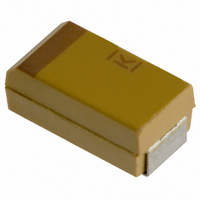T491B155K025AS Kemet, T491B155K025AS Datasheet - Page 70

T491B155K025AS
Manufacturer Part Number
T491B155K025AS
Description
CAPACITOR TANT 1.5UF 25V 10% SMD
Manufacturer
Kemet
Series
T491r
Type
Moldedr
Datasheet
1.T491B155K025AS.pdf
(100 pages)
Specifications of T491B155K025AS
Capacitance
1.5µF
Voltage - Rated
25V
Tolerance
±10%
Esr (equivalent Series Resistance)
5.000 Ohm
Operating Temperature
-55°C ~ 125°C
Mounting Type
Surface Mount
Package / Case
1210 (3528 Metric)
Size / Dimension
0.138" L x 0.110" W (3.50mm x 2.80mm)
Height
0.075" (1.90mm)
Manufacturer Size Code
B
Features
General Purpose
Lead Free Status / RoHS Status
Contains lead / RoHS non-compliant
Lead Spacing
-
Other names
399-1625-2
68
a capacitor under AC application. It is the ratio of the
equivalent series resistance to the capacitive reac-
tance, and is usually expressed in percent. It is normal-
ly measured simultaneously with capacitance, and
under the same conditions. The vector diagram below
illustrates the relationship between DF, ESR and
impedance. The reciprocal of the dissipation factor is
called the “Q” or quality factor. For convenience, the
“Q” factor is often used for very low values of dissipa-
tion factor especially when measured at high frequen-
cies. DF is sometimes called the “loss tangent” or “tan-
gent ”, as shown in Figure 2.
©KEMET Electronics Corporation, P.O. Box 5928, Greenville, S.C. 29606, (864) 963-6300
Dissipation factor (DF) is a measure of the losses in
Dielectric Strength: At 2.5 times rated DC voltage
Insulation Resistance (IR): At rated DC voltage, whichever
of the two is smaller. To get IR limit, divide M
the capacitance and compare to G limit. Select the lower
of the two limits.
Capacitance & Dissipation Factor: Measured at following
conditions:
Temperature: Range, C
DF Limits:
Capacitance Change (without DC voltage)
C0G – 1kHz and 1 vrms if capacitance >1000 pF
X7R/X5R/Y5V – 1kHz and 1 vrms* if capacitance 10 F
X7R/X5R/Y5V – 120Hz and 0.5 vrms if capacitance 10 F
Z5U – 1kHz and 0.5 vrms
=
1MHz and 1 vrms if capacitance 1000 pF
**X5R
<25V
<25V
1
Parameter
fC
CERAMIC CHIP CAPACITORS
<564
Cap
564
10.0%
5.0%
DF
X
c
Table 3 – Specified Electrical Limits
50 - 200 volts –
6.3/10 volts –
25 volts –
16 volts –
ESR
F value by
O
0
1,000 M – F
(100,000 M )
-55 to +125
or 100 G
30 ppm/ C
0.10%
0.10%
--------
--------
C0G
X7R:
X5R:
high, the total impedance of the capacitor can be
approximated by:
quency determines its effectiveness in many applica-
tions. At high frequency more detailed models apply -
see KEMET SPICE models for such instances.
to resist the flow of DC leakage current. It is sometimes
referred to as “leakage resistance”. Insulation resis-
tance (IR) is the DC resistance measured across the
terminals of a capacitor, represented by the parallel
resistance (IR) shown in Figure 1. For a given dielectric
type, electrode area increases with capacitance, result-
ing in a decrease in the insulation resistance.
Consequently, insulation resistance limits are usually
specified as the “RC” (IR x C) product, in terms of ohm-
farads or megohm-micro-farads. The insulation resis-
tance for a specific capacitance value is determined by
dividing this product by the capacitance. However, as
the nominal capacitance values become small, the
insulation resistance calculated from the RC product
reaches values which are impractical. Consequently, IR
specifications usually include both a minimum RC prod-
uct and a maximum limit based on the IR calculated
Temperature Characteristics
Where :
1,000 M – F
(100,000 M )
X7R/X5R
2.5%
3.5%
3.5%
5.0%
Since the parallel resistance (IR) is normally very
The variation of a capacitor's impedance with fre-
Insulation Resistance is the measure of a capacitor
or 100 G
-55 to +125 15%
-55 to +85 15%
Pass Subsequent IR Test
2.5%
5.0%
**
**
4
100 M – F
(10,000 M )
+22% -56%
+10 to +85
5
or 10 G
Z5U
4.0%
4.0%
-------
or 10 G ( 16 volt)
100 M – F
or 10G ( 10v)
(10,000 M )
50 M – F
+22% -82%
-30 to +85
10.0%
Y5V
5.0%
7.0%
7.0%











